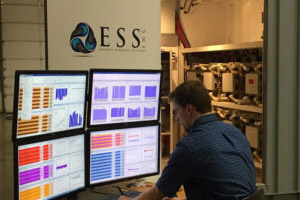The all-iron redox flow battery (IFB) from Energy Storage Systems, Inc. (ESS) has the potential to provide safer energy storage at a lower cost relative to typical battery options. The ESS battery uses three main electrolyte components—iron, salt, and water. Unlike other flow battery chemistries such as vanadium, the electrolyte components in the ESS battery are abundant, cost-effective, and nontoxic. According to ESS, the IFB can maintain high round-trip efficiency with negligible degradation for thousands of deep charge/discharge cycles. Combined, these factors create the potential for cost-effective, long-duration energy storage.
THE IMPACT
This integrated battery and control system enables onsite management of intermittent renewables, adds resilience, and helps users avoid peak demand charges and time of use rates. Coupling on-site photovoltaic (PV) generation with energy storage, for example, can provide a smoother, more dispatchable resource than solar alone. Building owners can use the stored energy to take advantage of time-based utility rates and demand response opportunities, providing new value streams for themselves and the utility. The stored energy can also be used to power essential operations or facilities during extreme weather events and other power outages.
HOW IN2 IS HELPING
ESS had received assistance describing its value proposition using quantifiable metrics. To do this, the NREL team completed updates to the System Advisor Model (SAM) tool to include battery life and parasitic load details specific to ESS’s flow battery units. The addition of ESS’s battery will allow their company to collect these metrics by a trusted open-source tool.

